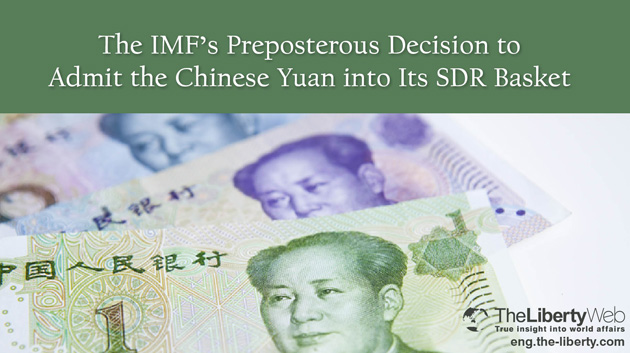The IMF’s Preposterous Decision to Admit the Chinese Yuan into Its SDR Basket
The International Monetary Fund (IMF) has decided to add the yuan, also known as the renminbi (RMB), to the Special Drawing Rights (SDR) basket of currencies.
According to the IMF, the yuan will become the fifth currency to make up the SDR basket from next October, after the US dollar, the euro, the British pound, and the yen. The basket composition is 41.73% for US dollar, 30.93% for the euro, 10.92% for the yuan, 8.33 % for the yen, and 8.09% for pound.
What Is SDR?
The SDR is called a currency basket. It is a virtual currency that consists of key international currencies. It is a currency that IMF member countries can use, not a currency that ordinary people can use to purchase clothing and food.
For example, if any IMF member country runs into a currency crisis and suffers from a foreign currency shortage, it sells part or all of its SDR allocations and props up its own currency. For this reason, the SDR has adopted stable currencies that maintain international credibility.
The IMF’s Managing Director, Christine Lagarde, explained the yuan’s inclusion in the SDR basket as follows:
The IMF Executive Board decision to include the yuan in the SDR basket is an important milestone in the integration of the Chinese economy into the global financial system. It is also recognition of the significant reforms that the Chinese authorities have conducted in the country’s currency and financial system over the past few years. The continuation and deepening of these efforts will bring about a more robust international monetary and financial system, which in turn will support the growth and stability of China and the global economy.
China Has Sought to Internationalize the Yuan
It can be said that the addition of the yuan to the SDR basket is a remarkable accomplishment for China. However, has China made real progress in the reforms of the monetary and financial system as Lagarde remarked?
The yuan had been pegged to the US dollar, at a flat rate of 8.27 yuan to the dollar, until 2005. The People’s Bank of China had set the exchange rate instead of letting the market determine the yuan’s value.
Then, the Chinese government started to adopt a more flexible exchange rate, allowing the currency to fluctuate, but when the global financial crisis occurred in 2008, it readopted the fixed exchange rate system to prevent the yuan from plunging, which revealed that the yuan was not a currency that could stand the rigors of the global financial market.
The Yuan Requires More Reforms
To be included in the SDR basket, a currency has to meet the criteria of being “freely usable”.
China has now adopted a managed floating, exchange-rate system that adjusts the yuan/USD exchange rate with reference to the SDR currency basket where the US dollar, the euro, and the yen have a higher weight. After all, the current state of the yuan is far from being reliable and “freely usable” for international trading.
Some European and American experts expect that the IMF’s decision this time may prompt the Chinese economy’s shift to a free floating, exchange rate system, but it is really an example of putting the cart before the horse.
The IMF should admit the yuan to the SDR basket only after China has reformed its foreign exchange and capital transaction systems, not in the hope that it will carry out reforms. The IMFshould not assume a lenient attitude towards China, but strictly examine whether the yuan is a reliable currency.



















